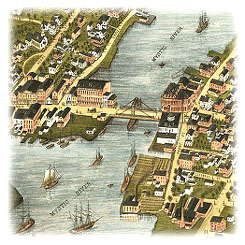 |
|
|
|||||||||||||||||||||||||||||||||||||||||
 I see bridges
I see bridges
When I see cyberspace, I see bridges. Perhaps I should say I see people, building bridges in cyberspace. Not bridges of steel, not even electronic bridges, but bridges of ideas that span the miles of physical space, cross the generations and connect people who would otherwise be unlikely ever to meet. As an educator and as Director of the Electronic Emissary Project, I see the opportunity for K-12 teachers and students to experience a new and enriching range of educational activities with knowledgeable, interesting and expert people throughout the world, a process called “telementoring”. It’s no secret that the Internet is becoming an integral part of schools and curriculum, even though in many schools Internet access is still limited to a few machines, perhaps in a library or computer lab. But the presence of the Internet alone doesn’t guarantee that great things are going to happen in the classroom. For one thing, most teacher training for using the Internet has focused on operating the tools, with little attention to the process of integrating the tools and resources into learning activities. Mastery of the tools is necessary, but it’s only the first step. Then teachers must identify how computer-based tools can be used to support new learning activities, and create a plan to structure classroom activities that take advantage of these new opportunities. Telementoring is an excellent example of a learning activity that would not be possible without Internet access. At the Electronic Emissary Project we’re building bridges in cyberspace through telementoring. We provide a “matching service” that assists K-12 teachers and students in contacting an expert in a subject or discipline for the purpose of setting up curriculum based discussions using e-mail, the web and other Internet communications tools. We’re also doing research, studying what happens when K-12 students and teachers get actively involved in long-term discussions with telementors.
One of the first things our research showed was that merely introducing a telementor to a classroom teacher and arranging for an exchange of e-mail addresses wasn’t enough to ensure a successful telementoring relationship. Online communication is largely text based, and that led to some misunderstandings. Many of the telementors work with Internet access available on their desktops on demand, and are likely to be savvy to the ways of the web and e-mail. Classroom teachers, on the other hand, often have access to the web only on a limited basis (perhaps one day a week), and are less accustomed to net communications. We found, for instance, that telementors sometimes mistook a slow response to one of their e-mails for a lack of interest when the delay was actually caused by limited net access. To help the process work better, we added facilitators, who watch over and support the communications flow between the telementor and the class. The ideal facilitator is skilled both as an Internet communicator and as an educator. Most of our facilitators are graduate students here in the College of Education at the University of Texas in Austin. While it’s possible that all classroom teachers may someday gain enough experience with telementoring to manage the process without help, for now providing facilitators is the most important service the Electronic Emissary Project offers. You could think of our facilitators as the outside consultants on these cyberspace bridge building projects. We’ve built more than 400 bridges in cyberspace so far. Here are some examples: Students in a small rural school in northern California collected owl pellets to study bones and skeletons through their telementor, a biological researcher at Michigan State University. Eight groups of four girls each in an honors science program in a New England high school learned about DNA, heredity and its application to medical research (and the possibilities of a career in science as well) through a telementoring relationship with a graduate student at the University of Minnesota. The communication can take may forms. For example, a literature professor at the U.S.Naval Academy answered his e-mail from high school students in Delaware in character as Arthur Dimsdale of Hawthorne’s A Scarlet Letter. Our experience has shown that telementoring can bring meaningful new learning experiences at both ends of the telementoring relationship. Not only is classroom curriculum enriched as students get the opportunity to explore the depth of the telementor’s expertise, many telementors report that the experience of being questioned by fresh, even naive, young minds has pushed them to a new level of understanding of their field. Bridge building isn’t free. We estimate that each telementoring project costs about $650.00. We need funding to continue to bring telementoring into more classrooms, free of cost to schools. We also need more knowledgeable people willing to volunteer their time as telementors. If you share my vision and want to see more bridges being built in cyberspace write to me at judi.harris@mail.utexas.edu. Copyright © 1999, 2000 media.org. |
||||||||||||||||||||||||||||||||||||||||||
|


